Social Media Marketing and Business Performance Analysis
VerifiedAdded on 2022/10/12
|27
|8317
|31
Report
AI Summary
This report investigates the significant impact of social media marketing on business growth and performance. The study, based on a survey of 64 participants, reveals the widespread acceptance of social media marketing as an effective tool for enhancing business outcomes. The research demonstrates a positive correlation between social media marketing strategies and key business metrics, including impulse purchases, increased sales, and reduced advertising costs. The report delves into the adoption and usage of social media in businesses, highlighting its role in brand recognition and customer engagement. It examines the challenges faced by businesses in leveraging social media, such as the lack of technological knowledge, time constraints, and government restrictions. The findings underscore the importance of social media marketing in the contemporary business landscape and provide insights for business owners seeking to improve their marketing strategies.
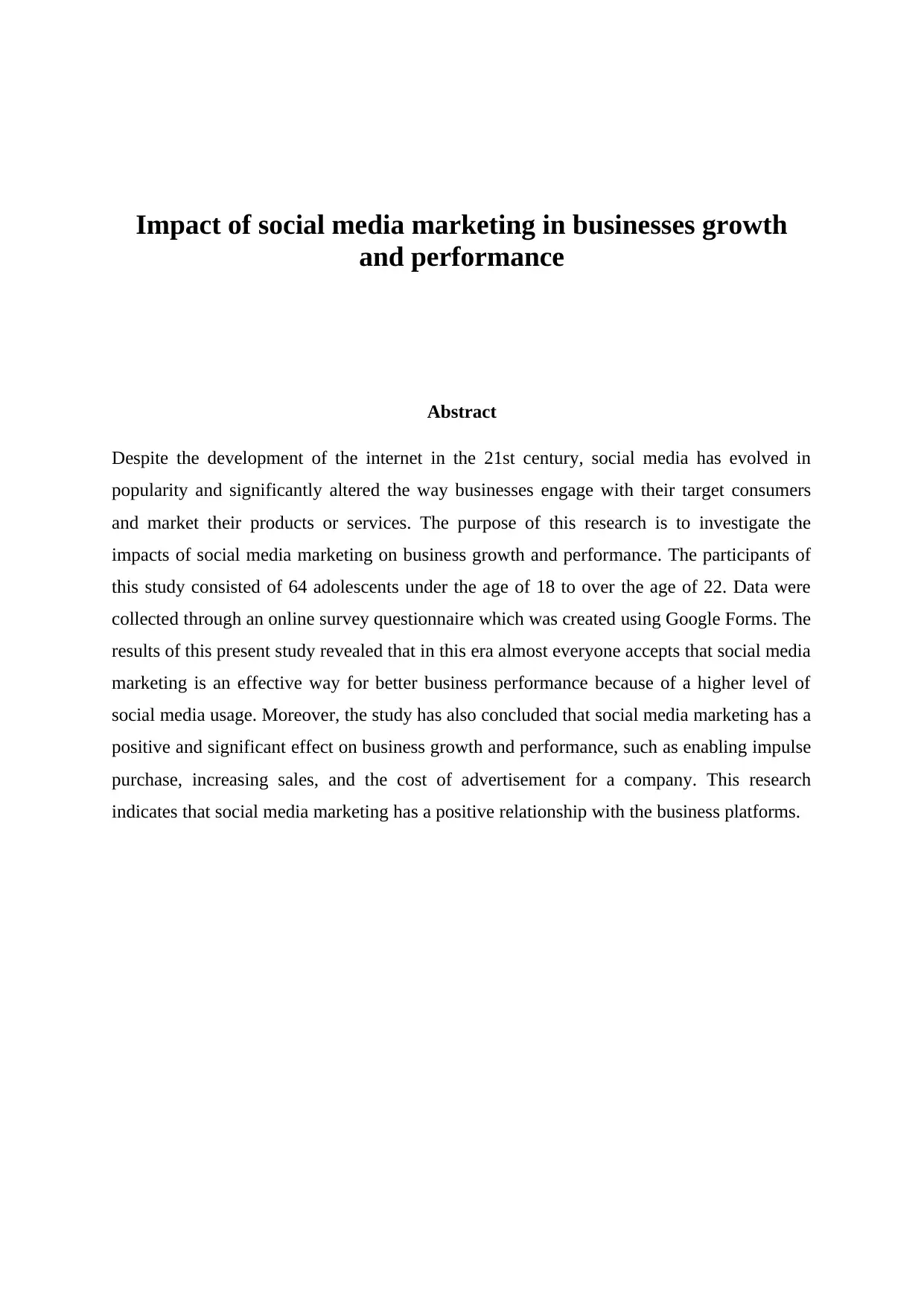
Impact of social media marketing in businesses growth
and performance
Abstract
Despite the development of the internet in the 21st century, social media has evolved in
popularity and significantly altered the way businesses engage with their target consumers
and market their products or services. The purpose of this research is to investigate the
impacts of social media marketing on business growth and performance. The participants of
this study consisted of 64 adolescents under the age of 18 to over the age of 22. Data were
collected through an online survey questionnaire which was created using Google Forms. The
results of this present study revealed that in this era almost everyone accepts that social media
marketing is an effective way for better business performance because of a higher level of
social media usage. Moreover, the study has also concluded that social media marketing has a
positive and significant effect on business growth and performance, such as enabling impulse
purchase, increasing sales, and the cost of advertisement for a company. This research
indicates that social media marketing has a positive relationship with the business platforms.
and performance
Abstract
Despite the development of the internet in the 21st century, social media has evolved in
popularity and significantly altered the way businesses engage with their target consumers
and market their products or services. The purpose of this research is to investigate the
impacts of social media marketing on business growth and performance. The participants of
this study consisted of 64 adolescents under the age of 18 to over the age of 22. Data were
collected through an online survey questionnaire which was created using Google Forms. The
results of this present study revealed that in this era almost everyone accepts that social media
marketing is an effective way for better business performance because of a higher level of
social media usage. Moreover, the study has also concluded that social media marketing has a
positive and significant effect on business growth and performance, such as enabling impulse
purchase, increasing sales, and the cost of advertisement for a company. This research
indicates that social media marketing has a positive relationship with the business platforms.
Paraphrase This Document
Need a fresh take? Get an instant paraphrase of this document with our AI Paraphraser
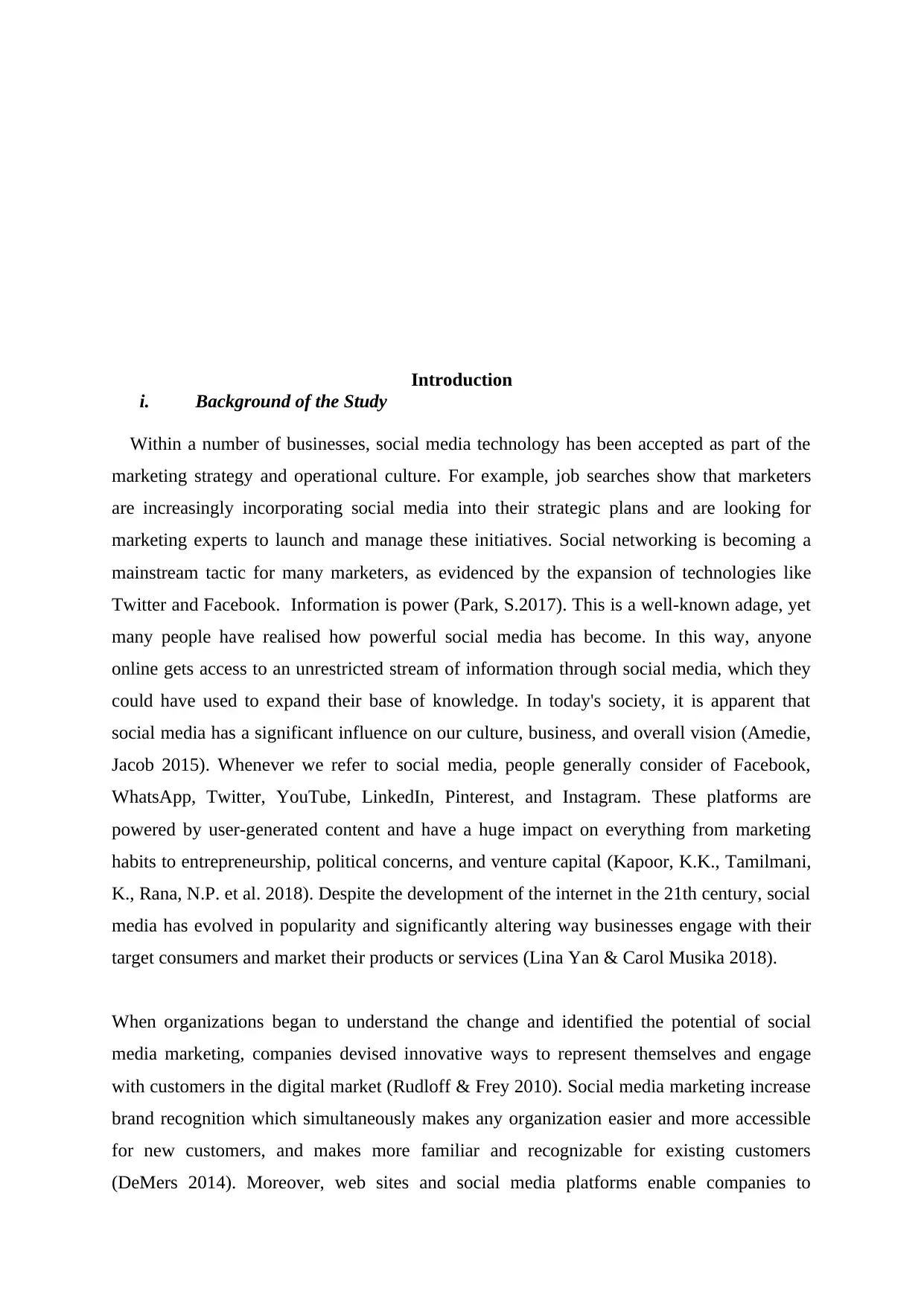
Introduction
i. Background of the Study
Within a number of businesses, social media technology has been accepted as part of the
marketing strategy and operational culture. For example, job searches show that marketers
are increasingly incorporating social media into their strategic plans and are looking for
marketing experts to launch and manage these initiatives. Social networking is becoming a
mainstream tactic for many marketers, as evidenced by the expansion of technologies like
Twitter and Facebook. Information is power (Park, S.2017). This is a well-known adage, yet
many people have realised how powerful social media has become. In this way, anyone
online gets access to an unrestricted stream of information through social media, which they
could have used to expand their base of knowledge. In today's society, it is apparent that
social media has a significant influence on our culture, business, and overall vision (Amedie,
Jacob 2015). Whenever we refer to social media, people generally consider of Facebook,
WhatsApp, Twitter, YouTube, LinkedIn, Pinterest, and Instagram. These platforms are
powered by user-generated content and have a huge impact on everything from marketing
habits to entrepreneurship, political concerns, and venture capital (Kapoor, K.K., Tamilmani,
K., Rana, N.P. et al. 2018). Despite the development of the internet in the 21th century, social
media has evolved in popularity and significantly altering way businesses engage with their
target consumers and market their products or services (Lina Yan & Carol Musika 2018).
When organizations began to understand the change and identified the potential of social
media marketing, companies devised innovative ways to represent themselves and engage
with customers in the digital market (Rudloff & Frey 2010). Social media marketing increase
brand recognition which simultaneously makes any organization easier and more accessible
for new customers, and makes more familiar and recognizable for existing customers
(DeMers 2014). Moreover, web sites and social media platforms enable companies to
i. Background of the Study
Within a number of businesses, social media technology has been accepted as part of the
marketing strategy and operational culture. For example, job searches show that marketers
are increasingly incorporating social media into their strategic plans and are looking for
marketing experts to launch and manage these initiatives. Social networking is becoming a
mainstream tactic for many marketers, as evidenced by the expansion of technologies like
Twitter and Facebook. Information is power (Park, S.2017). This is a well-known adage, yet
many people have realised how powerful social media has become. In this way, anyone
online gets access to an unrestricted stream of information through social media, which they
could have used to expand their base of knowledge. In today's society, it is apparent that
social media has a significant influence on our culture, business, and overall vision (Amedie,
Jacob 2015). Whenever we refer to social media, people generally consider of Facebook,
WhatsApp, Twitter, YouTube, LinkedIn, Pinterest, and Instagram. These platforms are
powered by user-generated content and have a huge impact on everything from marketing
habits to entrepreneurship, political concerns, and venture capital (Kapoor, K.K., Tamilmani,
K., Rana, N.P. et al. 2018). Despite the development of the internet in the 21th century, social
media has evolved in popularity and significantly altering way businesses engage with their
target consumers and market their products or services (Lina Yan & Carol Musika 2018).
When organizations began to understand the change and identified the potential of social
media marketing, companies devised innovative ways to represent themselves and engage
with customers in the digital market (Rudloff & Frey 2010). Social media marketing increase
brand recognition which simultaneously makes any organization easier and more accessible
for new customers, and makes more familiar and recognizable for existing customers
(DeMers 2014). Moreover, web sites and social media platforms enable companies to
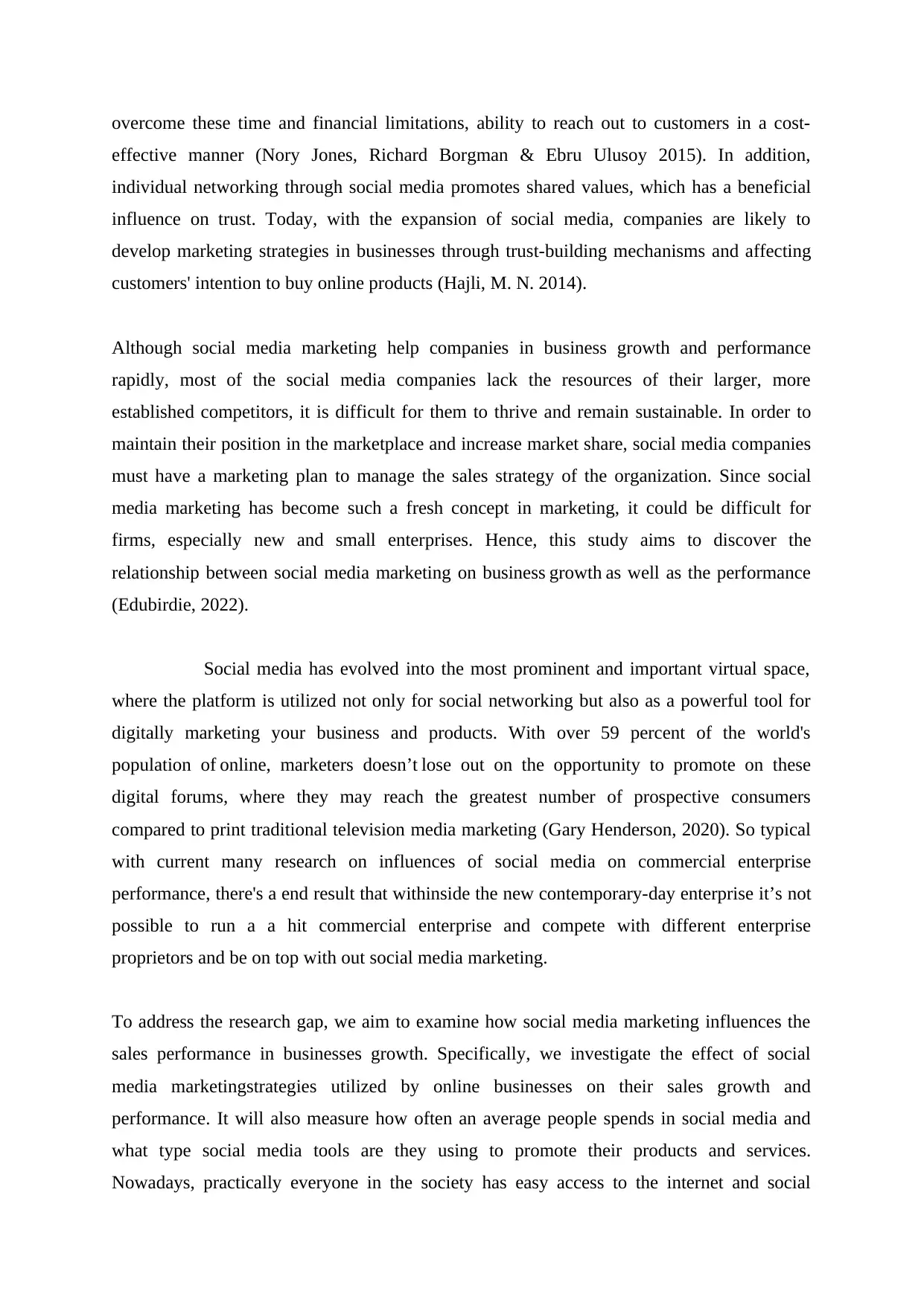
overcome these time and financial limitations, ability to reach out to customers in a cost-
effective manner (Nory Jones, Richard Borgman & Ebru Ulusoy 2015). In addition,
individual networking through social media promotes shared values, which has a beneficial
influence on trust. Today, with the expansion of social media, companies are likely to
develop marketing strategies in businesses through trust-building mechanisms and affecting
customers' intention to buy online products (Hajli, M. N. 2014).
Although social media marketing help companies in business growth and performance
rapidly, most of the social media companies lack the resources of their larger, more
established competitors, it is difficult for them to thrive and remain sustainable. In order to
maintain their position in the marketplace and increase market share, social media companies
must have a marketing plan to manage the sales strategy of the organization. Since social
media marketing has become such a fresh concept in marketing, it could be difficult for
firms, especially new and small enterprises. Hence, this study aims to discover the
relationship between social media marketing on business growth as well as the performance
(Edubirdie, 2022).
Social media has evolved into the most prominent and important virtual space,
where the platform is utilized not only for social networking but also as a powerful tool for
digitally marketing your business and products. With over 59 percent of the world's
population of online, marketers doesn’t lose out on the opportunity to promote on these
digital forums, where they may reach the greatest number of prospective consumers
compared to print traditional television media marketing (Gary Henderson, 2020). So typical
with current many research on influences of social media on commercial enterprise
performance, there's a end result that withinside the new contemporary-day enterprise it’s not
possible to run a a hit commercial enterprise and compete with different enterprise
proprietors and be on top with out social media marketing.
To address the research gap, we aim to examine how social media marketing influences the
sales performance in businesses growth. Specifically, we investigate the effect of social
media marketingstrategies utilized by online businesses on their sales growth and
performance. It will also measure how often an average people spends in social media and
what type social media tools are they using to promote their products and services.
Nowadays, practically everyone in the society has easy access to the internet and social
effective manner (Nory Jones, Richard Borgman & Ebru Ulusoy 2015). In addition,
individual networking through social media promotes shared values, which has a beneficial
influence on trust. Today, with the expansion of social media, companies are likely to
develop marketing strategies in businesses through trust-building mechanisms and affecting
customers' intention to buy online products (Hajli, M. N. 2014).
Although social media marketing help companies in business growth and performance
rapidly, most of the social media companies lack the resources of their larger, more
established competitors, it is difficult for them to thrive and remain sustainable. In order to
maintain their position in the marketplace and increase market share, social media companies
must have a marketing plan to manage the sales strategy of the organization. Since social
media marketing has become such a fresh concept in marketing, it could be difficult for
firms, especially new and small enterprises. Hence, this study aims to discover the
relationship between social media marketing on business growth as well as the performance
(Edubirdie, 2022).
Social media has evolved into the most prominent and important virtual space,
where the platform is utilized not only for social networking but also as a powerful tool for
digitally marketing your business and products. With over 59 percent of the world's
population of online, marketers doesn’t lose out on the opportunity to promote on these
digital forums, where they may reach the greatest number of prospective consumers
compared to print traditional television media marketing (Gary Henderson, 2020). So typical
with current many research on influences of social media on commercial enterprise
performance, there's a end result that withinside the new contemporary-day enterprise it’s not
possible to run a a hit commercial enterprise and compete with different enterprise
proprietors and be on top with out social media marketing.
To address the research gap, we aim to examine how social media marketing influences the
sales performance in businesses growth. Specifically, we investigate the effect of social
media marketingstrategies utilized by online businesses on their sales growth and
performance. It will also measure how often an average people spends in social media and
what type social media tools are they using to promote their products and services.
Nowadays, practically everyone in the society has easy access to the internet and social
⊘ This is a preview!⊘
Do you want full access?
Subscribe today to unlock all pages.

Trusted by 1+ million students worldwide
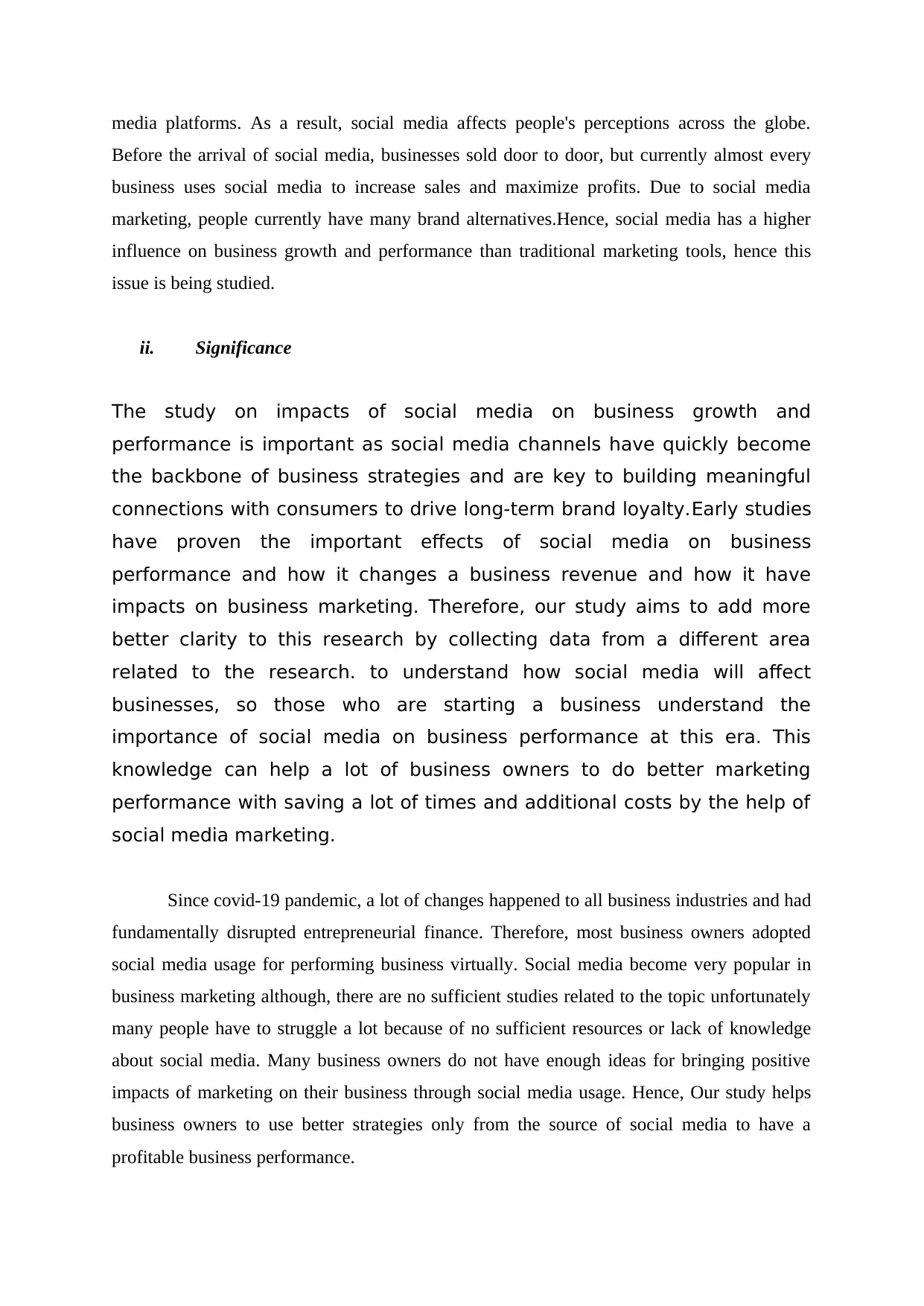
media platforms. As a result, social media affects people's perceptions across the globe.
Before the arrival of social media, businesses sold door to door, but currently almost every
business uses social media to increase sales and maximize profits. Due to social media
marketing, people currently have many brand alternatives.Hence, social media has a higher
influence on business growth and performance than traditional marketing tools, hence this
issue is being studied.
ii. Significance
The study on impacts of social media on business growth and
performance is important as social media channels have quickly become
the backbone of business strategies and are key to building meaningful
connections with consumers to drive long-term brand loyalty.Early studies
have proven the important effects of social media on business
performance and how it changes a business revenue and how it have
impacts on business marketing. Therefore, our study aims to add more
better clarity to this research by collecting data from a different area
related to the research. to understand how social media will affect
businesses, so those who are starting a business understand the
importance of social media on business performance at this era. This
knowledge can help a lot of business owners to do better marketing
performance with saving a lot of times and additional costs by the help of
social media marketing.
Since covid-19 pandemic, a lot of changes happened to all business industries and had
fundamentally disrupted entrepreneurial finance. Therefore, most business owners adopted
social media usage for performing business virtually. Social media become very popular in
business marketing although, there are no sufficient studies related to the topic unfortunately
many people have to struggle a lot because of no sufficient resources or lack of knowledge
about social media. Many business owners do not have enough ideas for bringing positive
impacts of marketing on their business through social media usage. Hence, Our study helps
business owners to use better strategies only from the source of social media to have a
profitable business performance.
Before the arrival of social media, businesses sold door to door, but currently almost every
business uses social media to increase sales and maximize profits. Due to social media
marketing, people currently have many brand alternatives.Hence, social media has a higher
influence on business growth and performance than traditional marketing tools, hence this
issue is being studied.
ii. Significance
The study on impacts of social media on business growth and
performance is important as social media channels have quickly become
the backbone of business strategies and are key to building meaningful
connections with consumers to drive long-term brand loyalty.Early studies
have proven the important effects of social media on business
performance and how it changes a business revenue and how it have
impacts on business marketing. Therefore, our study aims to add more
better clarity to this research by collecting data from a different area
related to the research. to understand how social media will affect
businesses, so those who are starting a business understand the
importance of social media on business performance at this era. This
knowledge can help a lot of business owners to do better marketing
performance with saving a lot of times and additional costs by the help of
social media marketing.
Since covid-19 pandemic, a lot of changes happened to all business industries and had
fundamentally disrupted entrepreneurial finance. Therefore, most business owners adopted
social media usage for performing business virtually. Social media become very popular in
business marketing although, there are no sufficient studies related to the topic unfortunately
many people have to struggle a lot because of no sufficient resources or lack of knowledge
about social media. Many business owners do not have enough ideas for bringing positive
impacts of marketing on their business through social media usage. Hence, Our study helps
business owners to use better strategies only from the source of social media to have a
profitable business performance.
Paraphrase This Document
Need a fresh take? Get an instant paraphrase of this document with our AI Paraphraser
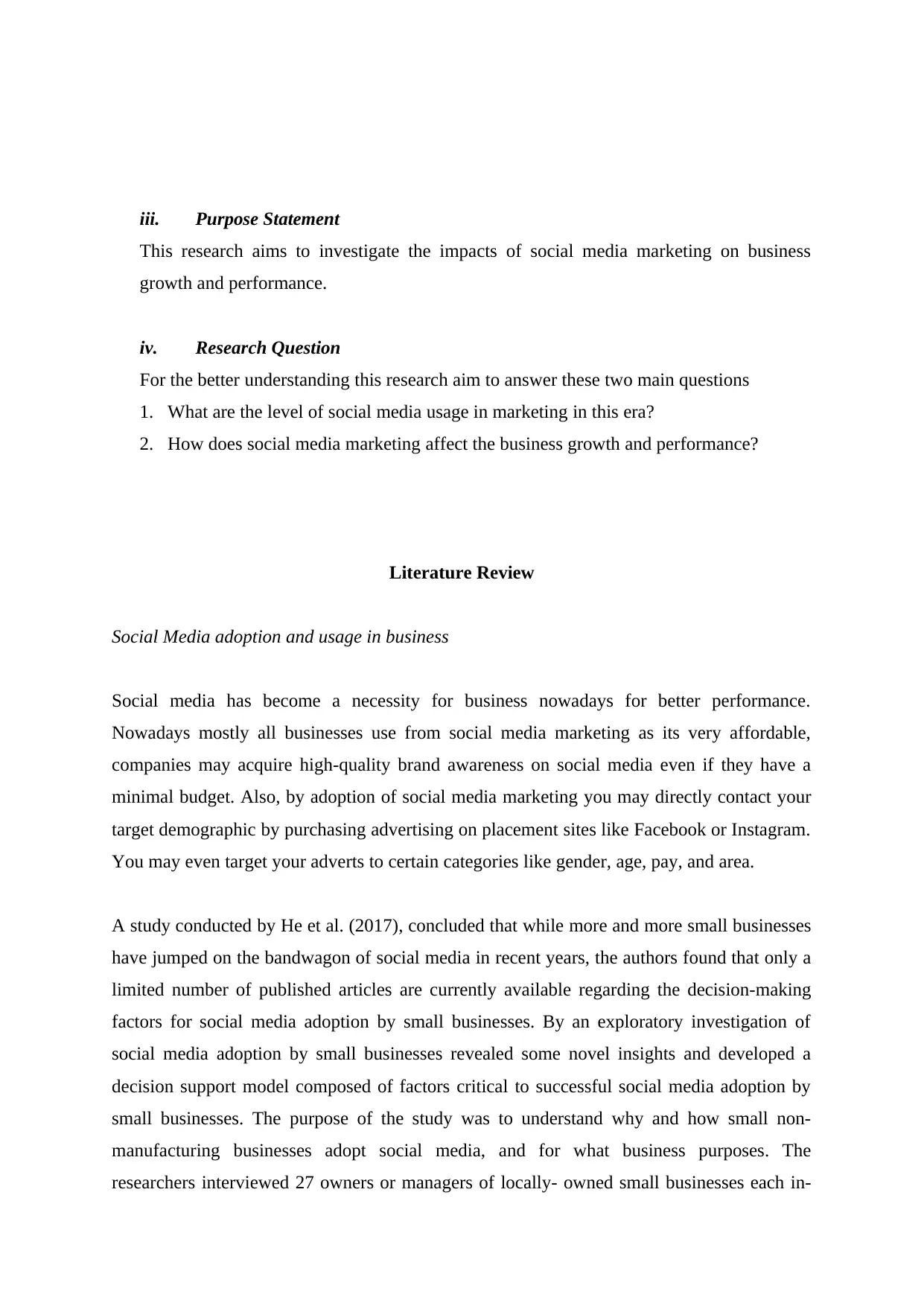
iii. Purpose Statement
This research aims to investigate the impacts of social media marketing on business
growth and performance.
iv. Research Question
For the better understanding this research aim to answer these two main questions
1. What are the level of social media usage in marketing in this era?
2. How does social media marketing affect the business growth and performance?
Literature Review
Social Media adoption and usage in business
Social media has become a necessity for business nowadays for better performance.
Nowadays mostly all businesses use from social media marketing as its very affordable,
companies may acquire high-quality brand awareness on social media even if they have a
minimal budget. Also, by adoption of social media marketing you may directly contact your
target demographic by purchasing advertising on placement sites like Facebook or Instagram.
You may even target your adverts to certain categories like gender, age, pay, and area.
A study conducted by He et al. (2017), concluded that while more and more small businesses
have jumped on the bandwagon of social media in recent years, the authors found that only a
limited number of published articles are currently available regarding the decision-making
factors for social media adoption by small businesses. By an exploratory investigation of
social media adoption by small businesses revealed some novel insights and developed a
decision support model composed of factors critical to successful social media adoption by
small businesses. The purpose of the study was to understand why and how small non-
manufacturing businesses adopt social media, and for what business purposes. The
researchers interviewed 27 owners or managers of locally- owned small businesses each in-
This research aims to investigate the impacts of social media marketing on business
growth and performance.
iv. Research Question
For the better understanding this research aim to answer these two main questions
1. What are the level of social media usage in marketing in this era?
2. How does social media marketing affect the business growth and performance?
Literature Review
Social Media adoption and usage in business
Social media has become a necessity for business nowadays for better performance.
Nowadays mostly all businesses use from social media marketing as its very affordable,
companies may acquire high-quality brand awareness on social media even if they have a
minimal budget. Also, by adoption of social media marketing you may directly contact your
target demographic by purchasing advertising on placement sites like Facebook or Instagram.
You may even target your adverts to certain categories like gender, age, pay, and area.
A study conducted by He et al. (2017), concluded that while more and more small businesses
have jumped on the bandwagon of social media in recent years, the authors found that only a
limited number of published articles are currently available regarding the decision-making
factors for social media adoption by small businesses. By an exploratory investigation of
social media adoption by small businesses revealed some novel insights and developed a
decision support model composed of factors critical to successful social media adoption by
small businesses. The purpose of the study was to understand why and how small non-
manufacturing businesses adopt social media, and for what business purposes. The
researchers interviewed 27 owners or managers of locally- owned small businesses each in-
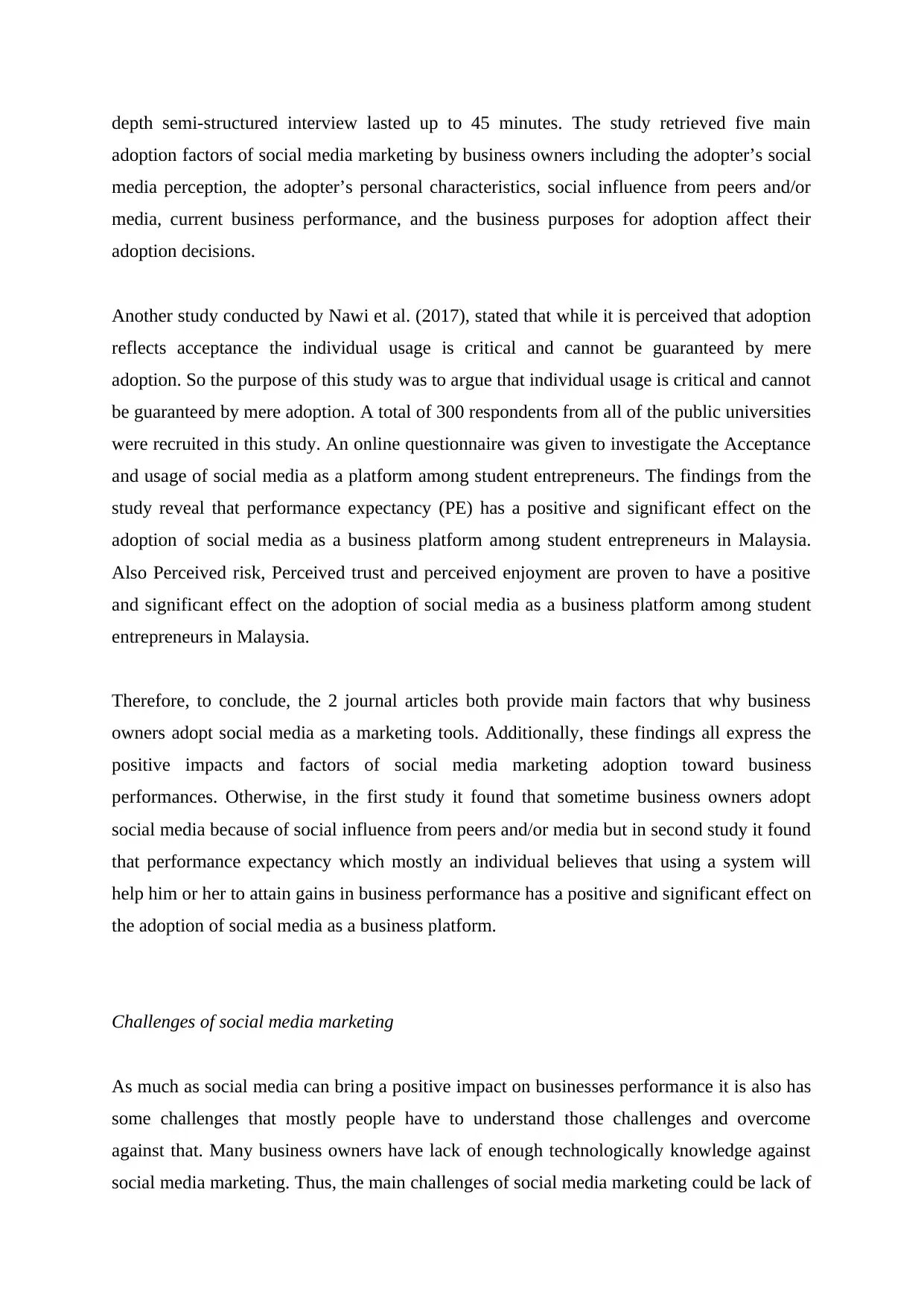
depth semi-structured interview lasted up to 45 minutes. The study retrieved five main
adoption factors of social media marketing by business owners including the adopter’s social
media perception, the adopter’s personal characteristics, social influence from peers and/or
media, current business performance, and the business purposes for adoption affect their
adoption decisions.
Another study conducted by Nawi et al. (2017), stated that while it is perceived that adoption
reflects acceptance the individual usage is critical and cannot be guaranteed by mere
adoption. So the purpose of this study was to argue that individual usage is critical and cannot
be guaranteed by mere adoption. A total of 300 respondents from all of the public universities
were recruited in this study. An online questionnaire was given to investigate the Acceptance
and usage of social media as a platform among student entrepreneurs. The findings from the
study reveal that performance expectancy (PE) has a positive and significant effect on the
adoption of social media as a business platform among student entrepreneurs in Malaysia.
Also Perceived risk, Perceived trust and perceived enjoyment are proven to have a positive
and significant effect on the adoption of social media as a business platform among student
entrepreneurs in Malaysia.
Therefore, to conclude, the 2 journal articles both provide main factors that why business
owners adopt social media as a marketing tools. Additionally, these findings all express the
positive impacts and factors of social media marketing adoption toward business
performances. Otherwise, in the first study it found that sometime business owners adopt
social media because of social influence from peers and/or media but in second study it found
that performance expectancy which mostly an individual believes that using a system will
help him or her to attain gains in business performance has a positive and significant effect on
the adoption of social media as a business platform.
Challenges of social media marketing
As much as social media can bring a positive impact on businesses performance it is also has
some challenges that mostly people have to understand those challenges and overcome
against that. Many business owners have lack of enough technologically knowledge against
social media marketing. Thus, the main challenges of social media marketing could be lack of
adoption factors of social media marketing by business owners including the adopter’s social
media perception, the adopter’s personal characteristics, social influence from peers and/or
media, current business performance, and the business purposes for adoption affect their
adoption decisions.
Another study conducted by Nawi et al. (2017), stated that while it is perceived that adoption
reflects acceptance the individual usage is critical and cannot be guaranteed by mere
adoption. So the purpose of this study was to argue that individual usage is critical and cannot
be guaranteed by mere adoption. A total of 300 respondents from all of the public universities
were recruited in this study. An online questionnaire was given to investigate the Acceptance
and usage of social media as a platform among student entrepreneurs. The findings from the
study reveal that performance expectancy (PE) has a positive and significant effect on the
adoption of social media as a business platform among student entrepreneurs in Malaysia.
Also Perceived risk, Perceived trust and perceived enjoyment are proven to have a positive
and significant effect on the adoption of social media as a business platform among student
entrepreneurs in Malaysia.
Therefore, to conclude, the 2 journal articles both provide main factors that why business
owners adopt social media as a marketing tools. Additionally, these findings all express the
positive impacts and factors of social media marketing adoption toward business
performances. Otherwise, in the first study it found that sometime business owners adopt
social media because of social influence from peers and/or media but in second study it found
that performance expectancy which mostly an individual believes that using a system will
help him or her to attain gains in business performance has a positive and significant effect on
the adoption of social media as a business platform.
Challenges of social media marketing
As much as social media can bring a positive impact on businesses performance it is also has
some challenges that mostly people have to understand those challenges and overcome
against that. Many business owners have lack of enough technologically knowledge against
social media marketing. Thus, the main challenges of social media marketing could be lack of
⊘ This is a preview!⊘
Do you want full access?
Subscribe today to unlock all pages.

Trusted by 1+ million students worldwide
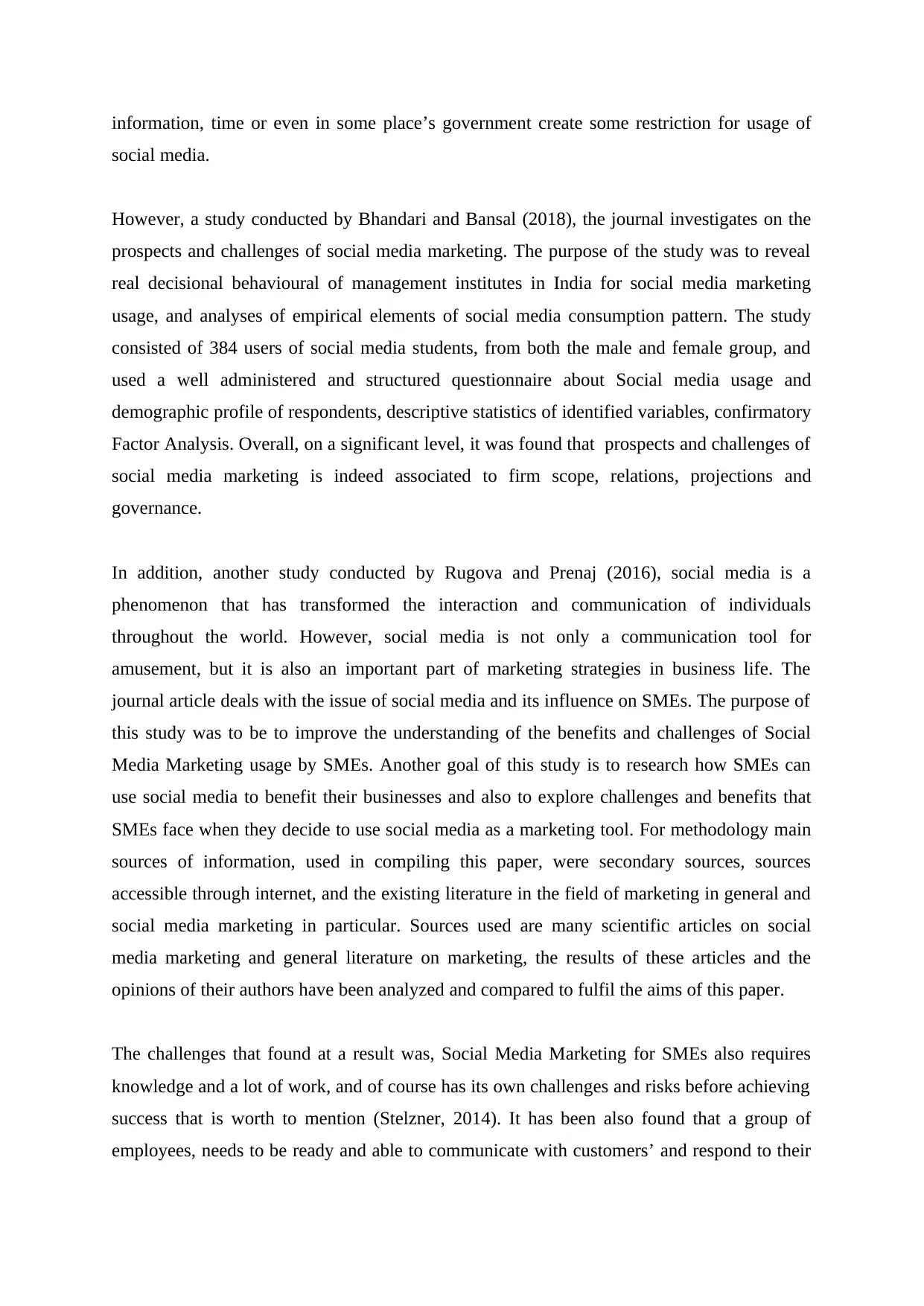
information, time or even in some place’s government create some restriction for usage of
social media.
However, a study conducted by Bhandari and Bansal (2018), the journal investigates on the
prospects and challenges of social media marketing. The purpose of the study was to reveal
real decisional behavioural of management institutes in India for social media marketing
usage, and analyses of empirical elements of social media consumption pattern. The study
consisted of 384 users of social media students, from both the male and female group, and
used a well administered and structured questionnaire about Social media usage and
demographic profile of respondents, descriptive statistics of identified variables, confirmatory
Factor Analysis. Overall, on a significant level, it was found that prospects and challenges of
social media marketing is indeed associated to firm scope, relations, projections and
governance.
In addition, another study conducted by Rugova and Prenaj (2016), social media is a
phenomenon that has transformed the interaction and communication of individuals
throughout the world. However, social media is not only a communication tool for
amusement, but it is also an important part of marketing strategies in business life. The
journal article deals with the issue of social media and its influence on SMEs. The purpose of
this study was to be to improve the understanding of the benefits and challenges of Social
Media Marketing usage by SMEs. Another goal of this study is to research how SMEs can
use social media to benefit their businesses and also to explore challenges and benefits that
SMEs face when they decide to use social media as a marketing tool. For methodology main
sources of information, used in compiling this paper, were secondary sources, sources
accessible through internet, and the existing literature in the field of marketing in general and
social media marketing in particular. Sources used are many scientific articles on social
media marketing and general literature on marketing, the results of these articles and the
opinions of their authors have been analyzed and compared to fulfil the aims of this paper.
The challenges that found at a result was, Social Media Marketing for SMEs also requires
knowledge and a lot of work, and of course has its own challenges and risks before achieving
success that is worth to mention (Stelzner, 2014). It has been also found that a group of
employees, needs to be ready and able to communicate with customers’ and respond to their
social media.
However, a study conducted by Bhandari and Bansal (2018), the journal investigates on the
prospects and challenges of social media marketing. The purpose of the study was to reveal
real decisional behavioural of management institutes in India for social media marketing
usage, and analyses of empirical elements of social media consumption pattern. The study
consisted of 384 users of social media students, from both the male and female group, and
used a well administered and structured questionnaire about Social media usage and
demographic profile of respondents, descriptive statistics of identified variables, confirmatory
Factor Analysis. Overall, on a significant level, it was found that prospects and challenges of
social media marketing is indeed associated to firm scope, relations, projections and
governance.
In addition, another study conducted by Rugova and Prenaj (2016), social media is a
phenomenon that has transformed the interaction and communication of individuals
throughout the world. However, social media is not only a communication tool for
amusement, but it is also an important part of marketing strategies in business life. The
journal article deals with the issue of social media and its influence on SMEs. The purpose of
this study was to be to improve the understanding of the benefits and challenges of Social
Media Marketing usage by SMEs. Another goal of this study is to research how SMEs can
use social media to benefit their businesses and also to explore challenges and benefits that
SMEs face when they decide to use social media as a marketing tool. For methodology main
sources of information, used in compiling this paper, were secondary sources, sources
accessible through internet, and the existing literature in the field of marketing in general and
social media marketing in particular. Sources used are many scientific articles on social
media marketing and general literature on marketing, the results of these articles and the
opinions of their authors have been analyzed and compared to fulfil the aims of this paper.
The challenges that found at a result was, Social Media Marketing for SMEs also requires
knowledge and a lot of work, and of course has its own challenges and risks before achieving
success that is worth to mention (Stelzner, 2014). It has been also found that a group of
employees, needs to be ready and able to communicate with customers’ and respond to their
Paraphrase This Document
Need a fresh take? Get an instant paraphrase of this document with our AI Paraphraser
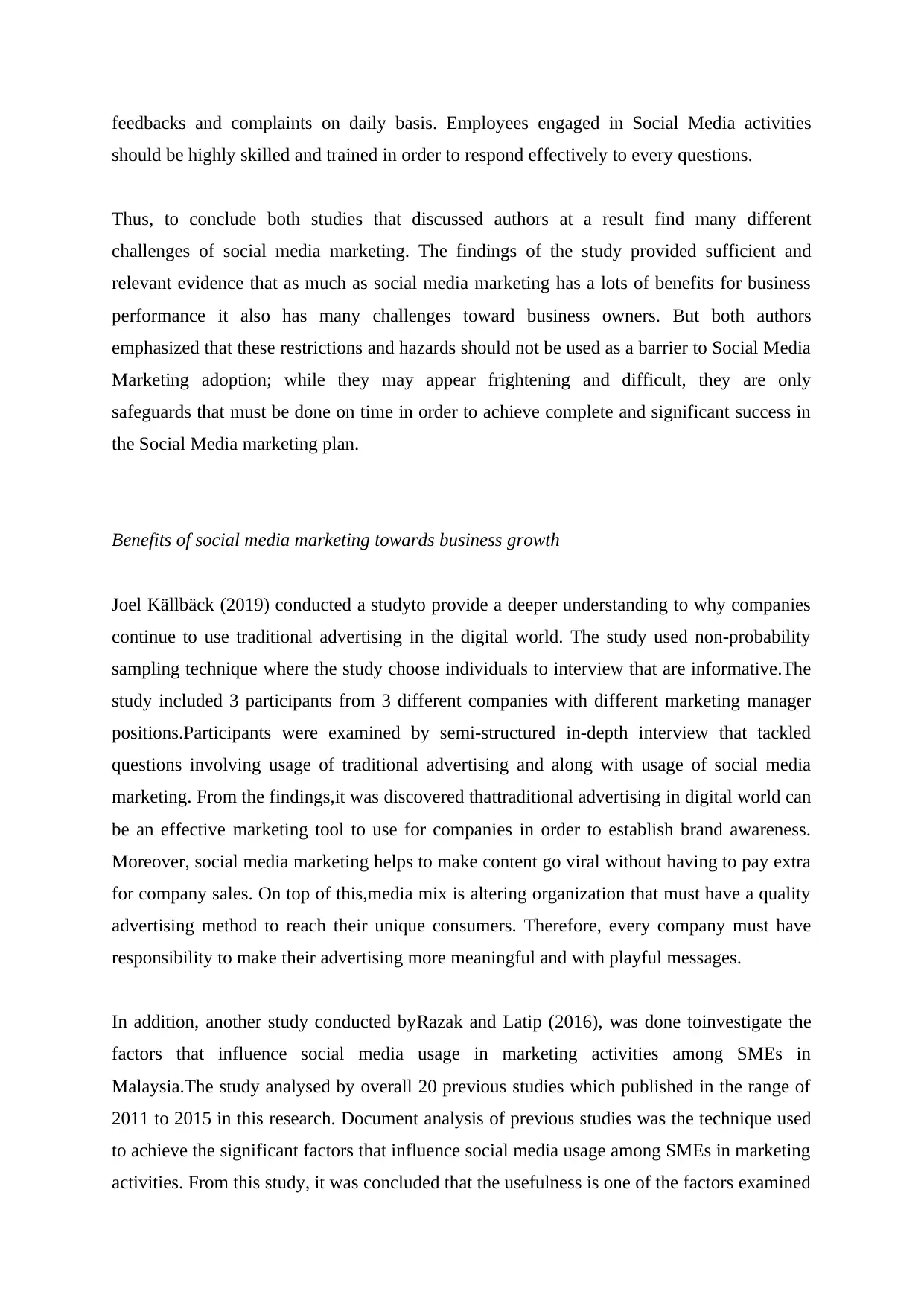
feedbacks and complaints on daily basis. Employees engaged in Social Media activities
should be highly skilled and trained in order to respond effectively to every questions.
Thus, to conclude both studies that discussed authors at a result find many different
challenges of social media marketing. The findings of the study provided sufficient and
relevant evidence that as much as social media marketing has a lots of benefits for business
performance it also has many challenges toward business owners. But both authors
emphasized that these restrictions and hazards should not be used as a barrier to Social Media
Marketing adoption; while they may appear frightening and difficult, they are only
safeguards that must be done on time in order to achieve complete and significant success in
the Social Media marketing plan.
Benefits of social media marketing towards business growth
Joel Källbäck (2019) conducted a studyto provide a deeper understanding to why companies
continue to use traditional advertising in the digital world. The study used non-probability
sampling technique where the study choose individuals to interview that are informative.The
study included 3 participants from 3 different companies with different marketing manager
positions.Participants were examined by semi-structured in-depth interview that tackled
questions involving usage of traditional advertising and along with usage of social media
marketing. From the findings,it was discovered thattraditional advertising in digital world can
be an effective marketing tool to use for companies in order to establish brand awareness.
Moreover, social media marketing helps to make content go viral without having to pay extra
for company sales. On top of this,media mix is altering organization that must have a quality
advertising method to reach their unique consumers. Therefore, every company must have
responsibility to make their advertising more meaningful and with playful messages.
In addition, another study conducted byRazak and Latip (2016), was done toinvestigate the
factors that influence social media usage in marketing activities among SMEs in
Malaysia.The study analysed by overall 20 previous studies which published in the range of
2011 to 2015 in this research. Document analysis of previous studies was the technique used
to achieve the significant factors that influence social media usage among SMEs in marketing
activities. From this study, it was concluded that the usefulness is one of the factors examined
should be highly skilled and trained in order to respond effectively to every questions.
Thus, to conclude both studies that discussed authors at a result find many different
challenges of social media marketing. The findings of the study provided sufficient and
relevant evidence that as much as social media marketing has a lots of benefits for business
performance it also has many challenges toward business owners. But both authors
emphasized that these restrictions and hazards should not be used as a barrier to Social Media
Marketing adoption; while they may appear frightening and difficult, they are only
safeguards that must be done on time in order to achieve complete and significant success in
the Social Media marketing plan.
Benefits of social media marketing towards business growth
Joel Källbäck (2019) conducted a studyto provide a deeper understanding to why companies
continue to use traditional advertising in the digital world. The study used non-probability
sampling technique where the study choose individuals to interview that are informative.The
study included 3 participants from 3 different companies with different marketing manager
positions.Participants were examined by semi-structured in-depth interview that tackled
questions involving usage of traditional advertising and along with usage of social media
marketing. From the findings,it was discovered thattraditional advertising in digital world can
be an effective marketing tool to use for companies in order to establish brand awareness.
Moreover, social media marketing helps to make content go viral without having to pay extra
for company sales. On top of this,media mix is altering organization that must have a quality
advertising method to reach their unique consumers. Therefore, every company must have
responsibility to make their advertising more meaningful and with playful messages.
In addition, another study conducted byRazak and Latip (2016), was done toinvestigate the
factors that influence social media usage in marketing activities among SMEs in
Malaysia.The study analysed by overall 20 previous studies which published in the range of
2011 to 2015 in this research. Document analysis of previous studies was the technique used
to achieve the significant factors that influence social media usage among SMEs in marketing
activities. From this study, it was concluded that the usefulness is one of the factors examined
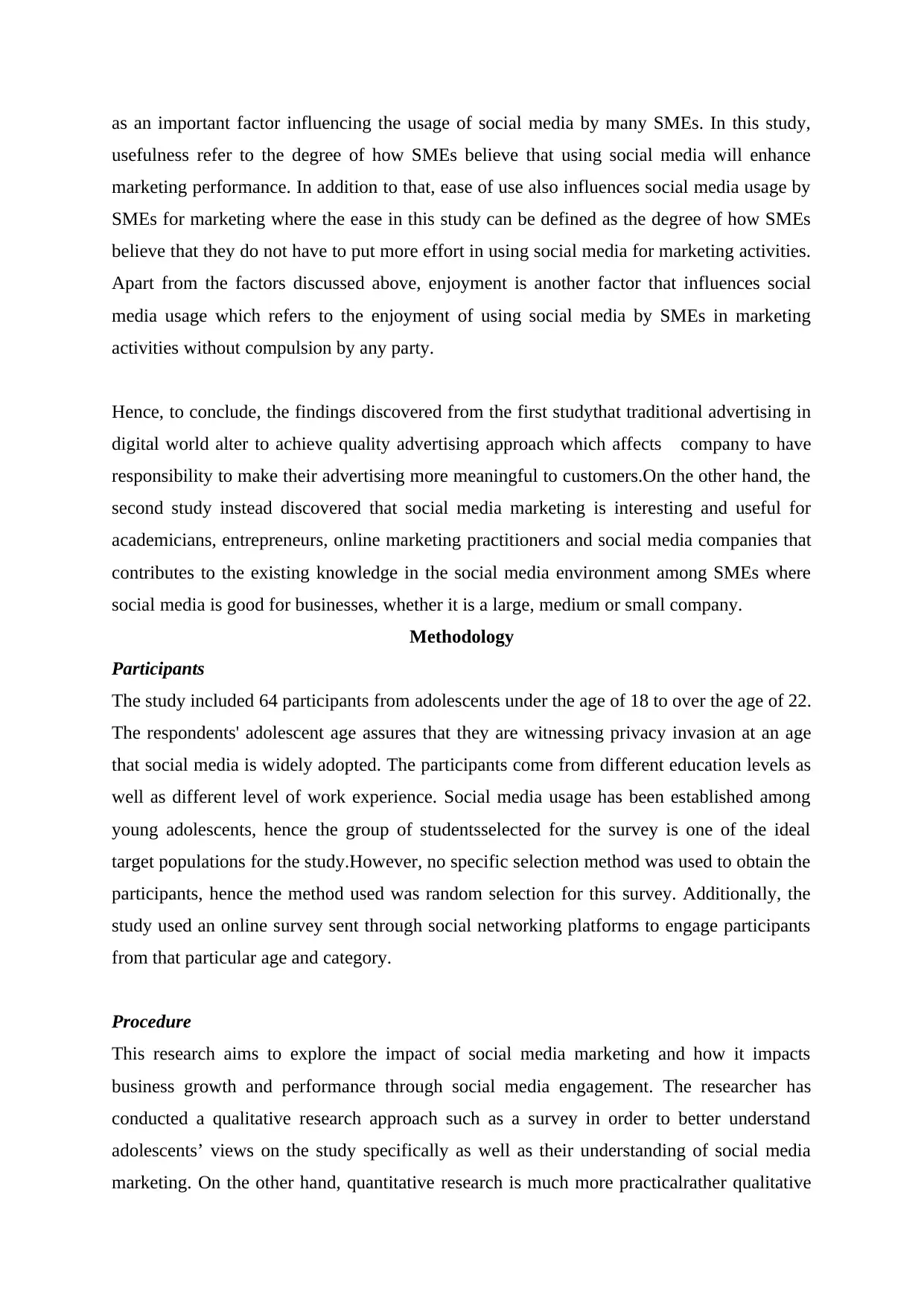
as an important factor influencing the usage of social media by many SMEs. In this study,
usefulness refer to the degree of how SMEs believe that using social media will enhance
marketing performance. In addition to that, ease of use also influences social media usage by
SMEs for marketing where the ease in this study can be defined as the degree of how SMEs
believe that they do not have to put more effort in using social media for marketing activities.
Apart from the factors discussed above, enjoyment is another factor that influences social
media usage which refers to the enjoyment of using social media by SMEs in marketing
activities without compulsion by any party.
Hence, to conclude, the findings discovered from the first studythat traditional advertising in
digital world alter to achieve quality advertising approach which affects company to have
responsibility to make their advertising more meaningful to customers.On the other hand, the
second study instead discovered that social media marketing is interesting and useful for
academicians, entrepreneurs, online marketing practitioners and social media companies that
contributes to the existing knowledge in the social media environment among SMEs where
social media is good for businesses, whether it is a large, medium or small company.
Methodology
Participants
The study included 64 participants from adolescents under the age of 18 to over the age of 22.
The respondents' adolescent age assures that they are witnessing privacy invasion at an age
that social media is widely adopted. The participants come from different education levels as
well as different level of work experience. Social media usage has been established among
young adolescents, hence the group of studentsselected for the survey is one of the ideal
target populations for the study.However, no specific selection method was used to obtain the
participants, hence the method used was random selection for this survey. Additionally, the
study used an online survey sent through social networking platforms to engage participants
from that particular age and category.
Procedure
This research aims to explore the impact of social media marketing and how it impacts
business growth and performance through social media engagement. The researcher has
conducted a qualitative research approach such as a survey in order to better understand
adolescents’ views on the study specifically as well as their understanding of social media
marketing. On the other hand, quantitative research is much more practicalrather qualitative
usefulness refer to the degree of how SMEs believe that using social media will enhance
marketing performance. In addition to that, ease of use also influences social media usage by
SMEs for marketing where the ease in this study can be defined as the degree of how SMEs
believe that they do not have to put more effort in using social media for marketing activities.
Apart from the factors discussed above, enjoyment is another factor that influences social
media usage which refers to the enjoyment of using social media by SMEs in marketing
activities without compulsion by any party.
Hence, to conclude, the findings discovered from the first studythat traditional advertising in
digital world alter to achieve quality advertising approach which affects company to have
responsibility to make their advertising more meaningful to customers.On the other hand, the
second study instead discovered that social media marketing is interesting and useful for
academicians, entrepreneurs, online marketing practitioners and social media companies that
contributes to the existing knowledge in the social media environment among SMEs where
social media is good for businesses, whether it is a large, medium or small company.
Methodology
Participants
The study included 64 participants from adolescents under the age of 18 to over the age of 22.
The respondents' adolescent age assures that they are witnessing privacy invasion at an age
that social media is widely adopted. The participants come from different education levels as
well as different level of work experience. Social media usage has been established among
young adolescents, hence the group of studentsselected for the survey is one of the ideal
target populations for the study.However, no specific selection method was used to obtain the
participants, hence the method used was random selection for this survey. Additionally, the
study used an online survey sent through social networking platforms to engage participants
from that particular age and category.
Procedure
This research aims to explore the impact of social media marketing and how it impacts
business growth and performance through social media engagement. The researcher has
conducted a qualitative research approach such as a survey in order to better understand
adolescents’ views on the study specifically as well as their understanding of social media
marketing. On the other hand, quantitative research is much more practicalrather qualitative
⊘ This is a preview!⊘
Do you want full access?
Subscribe today to unlock all pages.

Trusted by 1+ million students worldwide
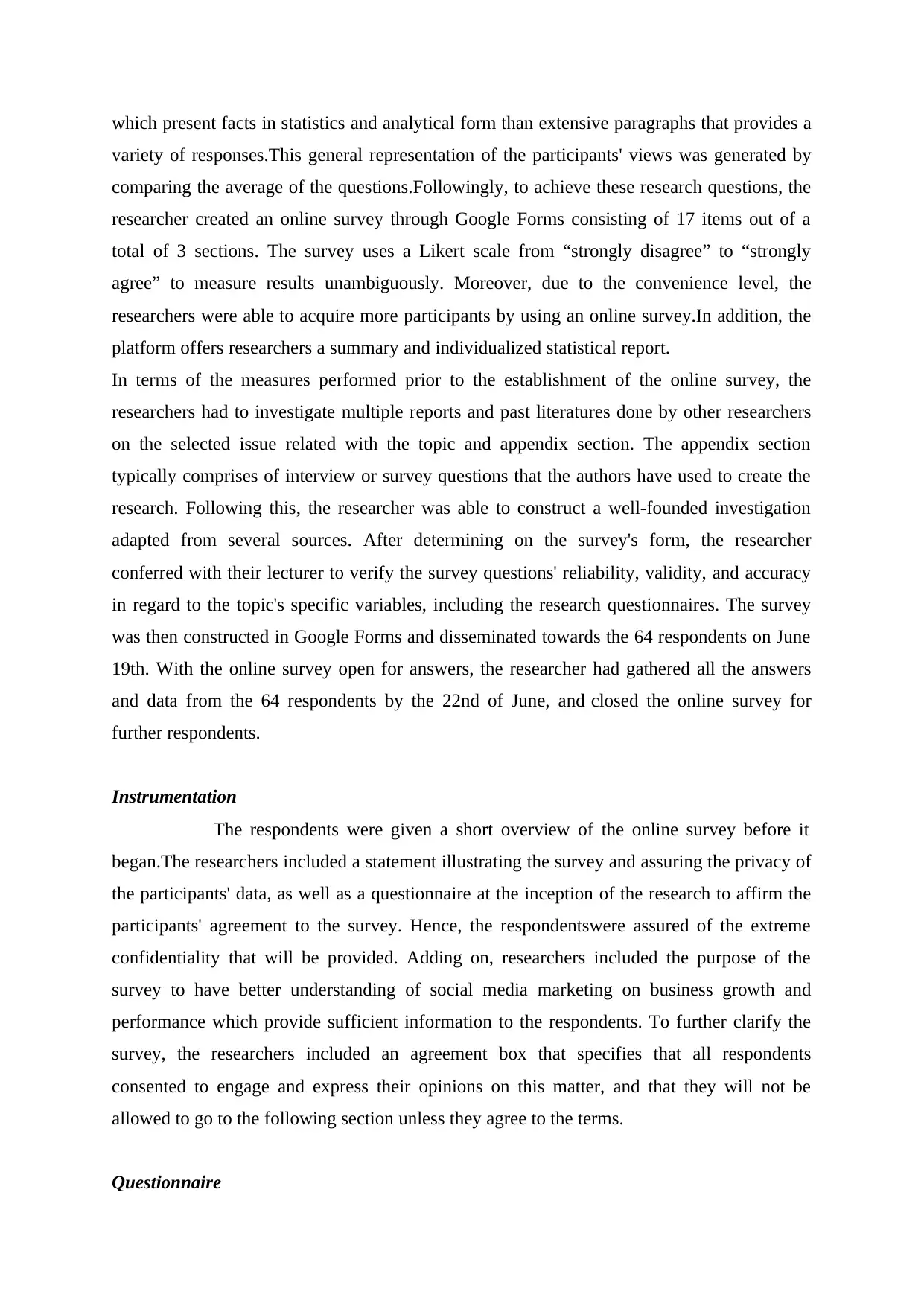
which present facts in statistics and analytical form than extensive paragraphs that provides a
variety of responses.This general representation of the participants' views was generated by
comparing the average of the questions.Followingly, to achieve these research questions, the
researcher created an online survey through Google Forms consisting of 17 items out of a
total of 3 sections. The survey uses a Likert scale from “strongly disagree” to “strongly
agree” to measure results unambiguously. Moreover, due to the convenience level, the
researchers were able to acquire more participants by using an online survey.In addition, the
platform offers researchers a summary and individualized statistical report.
In terms of the measures performed prior to the establishment of the online survey, the
researchers had to investigate multiple reports and past literatures done by other researchers
on the selected issue related with the topic and appendix section. The appendix section
typically comprises of interview or survey questions that the authors have used to create the
research. Following this, the researcher was able to construct a well-founded investigation
adapted from several sources. After determining on the survey's form, the researcher
conferred with their lecturer to verify the survey questions' reliability, validity, and accuracy
in regard to the topic's specific variables, including the research questionnaires. The survey
was then constructed in Google Forms and disseminated towards the 64 respondents on June
19th. With the online survey open for answers, the researcher had gathered all the answers
and data from the 64 respondents by the 22nd of June, and closed the online survey for
further respondents.
Instrumentation
The respondents were given a short overview of the online survey before it
began.The researchers included a statement illustrating the survey and assuring the privacy of
the participants' data, as well as a questionnaire at the inception of the research to affirm the
participants' agreement to the survey. Hence, the respondentswere assured of the extreme
confidentiality that will be provided. Adding on, researchers included the purpose of the
survey to have better understanding of social media marketing on business growth and
performance which provide sufficient information to the respondents. To further clarify the
survey, the researchers included an agreement box that specifies that all respondents
consented to engage and express their opinions on this matter, and that they will not be
allowed to go to the following section unless they agree to the terms.
Questionnaire
variety of responses.This general representation of the participants' views was generated by
comparing the average of the questions.Followingly, to achieve these research questions, the
researcher created an online survey through Google Forms consisting of 17 items out of a
total of 3 sections. The survey uses a Likert scale from “strongly disagree” to “strongly
agree” to measure results unambiguously. Moreover, due to the convenience level, the
researchers were able to acquire more participants by using an online survey.In addition, the
platform offers researchers a summary and individualized statistical report.
In terms of the measures performed prior to the establishment of the online survey, the
researchers had to investigate multiple reports and past literatures done by other researchers
on the selected issue related with the topic and appendix section. The appendix section
typically comprises of interview or survey questions that the authors have used to create the
research. Following this, the researcher was able to construct a well-founded investigation
adapted from several sources. After determining on the survey's form, the researcher
conferred with their lecturer to verify the survey questions' reliability, validity, and accuracy
in regard to the topic's specific variables, including the research questionnaires. The survey
was then constructed in Google Forms and disseminated towards the 64 respondents on June
19th. With the online survey open for answers, the researcher had gathered all the answers
and data from the 64 respondents by the 22nd of June, and closed the online survey for
further respondents.
Instrumentation
The respondents were given a short overview of the online survey before it
began.The researchers included a statement illustrating the survey and assuring the privacy of
the participants' data, as well as a questionnaire at the inception of the research to affirm the
participants' agreement to the survey. Hence, the respondentswere assured of the extreme
confidentiality that will be provided. Adding on, researchers included the purpose of the
survey to have better understanding of social media marketing on business growth and
performance which provide sufficient information to the respondents. To further clarify the
survey, the researchers included an agreement box that specifies that all respondents
consented to engage and express their opinions on this matter, and that they will not be
allowed to go to the following section unless they agree to the terms.
Questionnaire
Paraphrase This Document
Need a fresh take? Get an instant paraphrase of this document with our AI Paraphraser
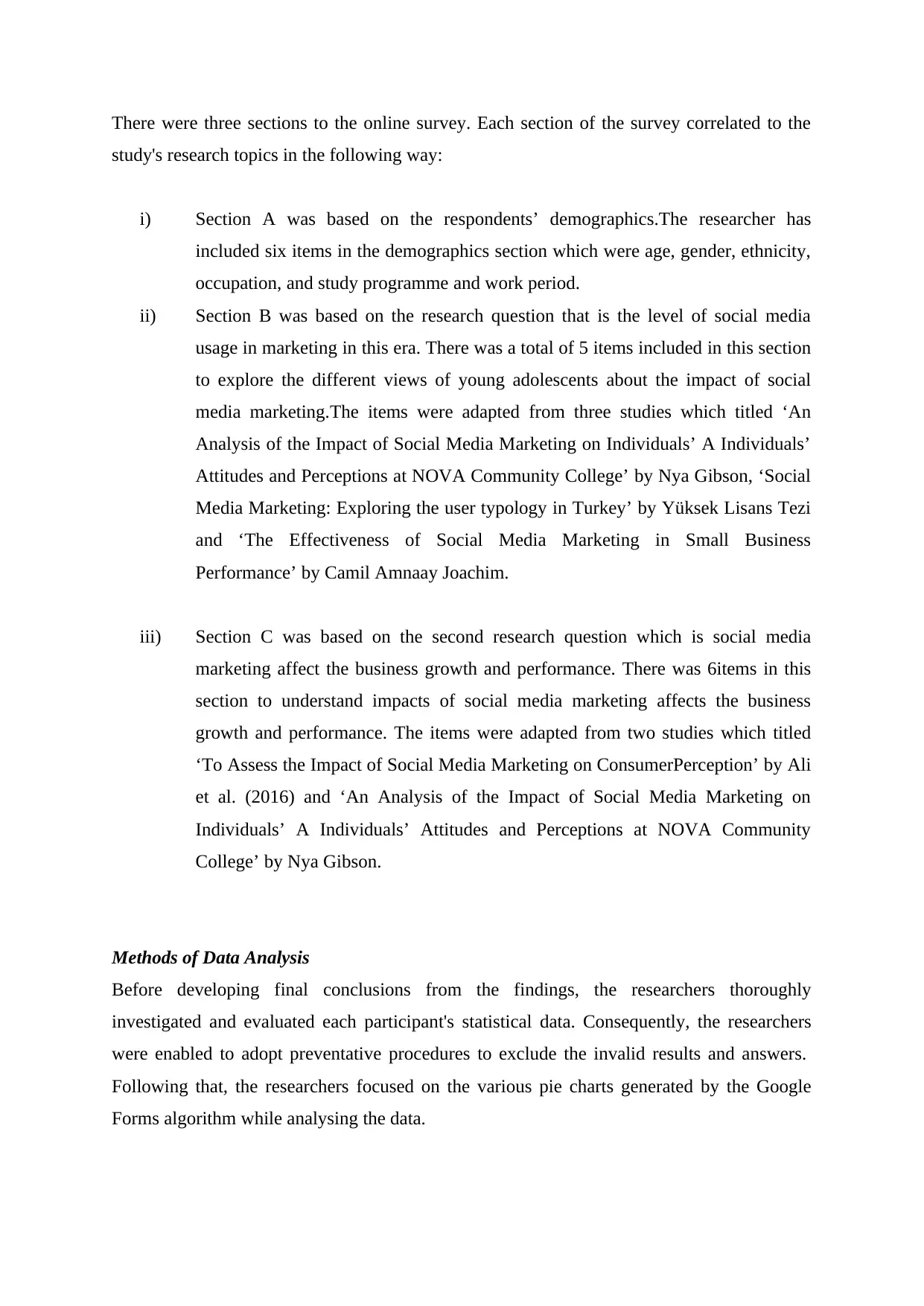
There were three sections to the online survey. Each section of the survey correlated to the
study's research topics in the following way:
i) Section A was based on the respondents’ demographics.The researcher has
included six items in the demographics section which were age, gender, ethnicity,
occupation, and study programme and work period.
ii) Section B was based on the research question that is the level of social media
usage in marketing in this era. There was a total of 5 items included in this section
to explore the different views of young adolescents about the impact of social
media marketing.The items were adapted from three studies which titled ‘An
Analysis of the Impact of Social Media Marketing on Individuals’ A Individuals’
Attitudes and Perceptions at NOVA Community College’ by Nya Gibson, ‘Social
Media Marketing: Exploring the user typology in Turkey’ by Yüksek Lisans Tezi
and ‘The Effectiveness of Social Media Marketing in Small Business
Performance’ by Camil Amnaay Joachim.
iii) Section C was based on the second research question which is social media
marketing affect the business growth and performance. There was 6items in this
section to understand impacts of social media marketing affects the business
growth and performance. The items were adapted from two studies which titled
‘To Assess the Impact of Social Media Marketing on ConsumerPerception’ by Ali
et al. (2016) and ‘An Analysis of the Impact of Social Media Marketing on
Individuals’ A Individuals’ Attitudes and Perceptions at NOVA Community
College’ by Nya Gibson.
Methods of Data Analysis
Before developing final conclusions from the findings, the researchers thoroughly
investigated and evaluated each participant's statistical data. Consequently, the researchers
were enabled to adopt preventative procedures to exclude the invalid results and answers.
Following that, the researchers focused on the various pie charts generated by the Google
Forms algorithm while analysing the data.
study's research topics in the following way:
i) Section A was based on the respondents’ demographics.The researcher has
included six items in the demographics section which were age, gender, ethnicity,
occupation, and study programme and work period.
ii) Section B was based on the research question that is the level of social media
usage in marketing in this era. There was a total of 5 items included in this section
to explore the different views of young adolescents about the impact of social
media marketing.The items were adapted from three studies which titled ‘An
Analysis of the Impact of Social Media Marketing on Individuals’ A Individuals’
Attitudes and Perceptions at NOVA Community College’ by Nya Gibson, ‘Social
Media Marketing: Exploring the user typology in Turkey’ by Yüksek Lisans Tezi
and ‘The Effectiveness of Social Media Marketing in Small Business
Performance’ by Camil Amnaay Joachim.
iii) Section C was based on the second research question which is social media
marketing affect the business growth and performance. There was 6items in this
section to understand impacts of social media marketing affects the business
growth and performance. The items were adapted from two studies which titled
‘To Assess the Impact of Social Media Marketing on ConsumerPerception’ by Ali
et al. (2016) and ‘An Analysis of the Impact of Social Media Marketing on
Individuals’ A Individuals’ Attitudes and Perceptions at NOVA Community
College’ by Nya Gibson.
Methods of Data Analysis
Before developing final conclusions from the findings, the researchers thoroughly
investigated and evaluated each participant's statistical data. Consequently, the researchers
were enabled to adopt preventative procedures to exclude the invalid results and answers.
Following that, the researchers focused on the various pie charts generated by the Google
Forms algorithm while analysing the data.
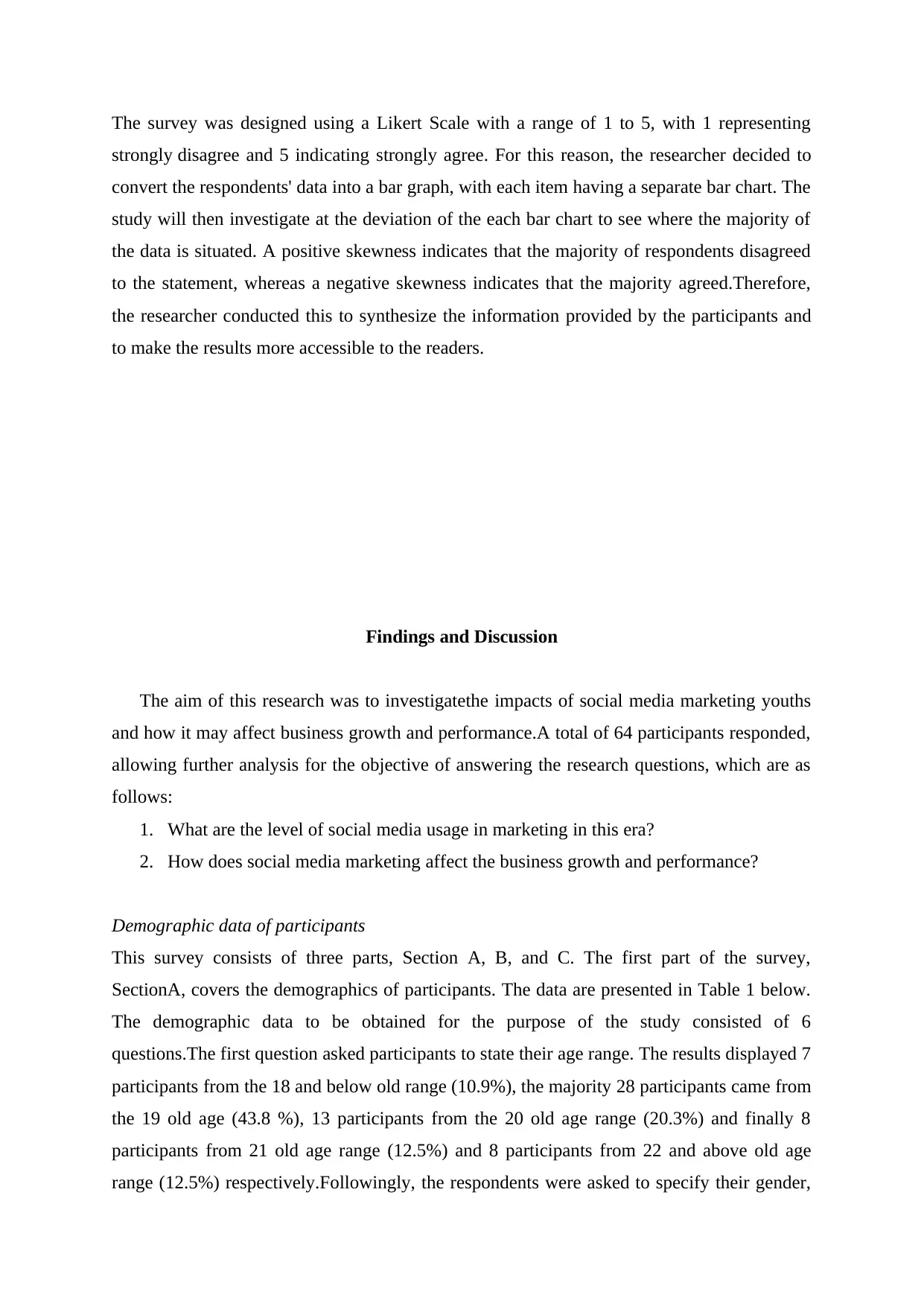
The survey was designed using a Likert Scale with a range of 1 to 5, with 1 representing
strongly disagree and 5 indicating strongly agree. For this reason, the researcher decided to
convert the respondents' data into a bar graph, with each item having a separate bar chart. The
study will then investigate at the deviation of the each bar chart to see where the majority of
the data is situated. A positive skewness indicates that the majority of respondents disagreed
to the statement, whereas a negative skewness indicates that the majority agreed.Therefore,
the researcher conducted this to synthesize the information provided by the participants and
to make the results more accessible to the readers.
Findings and Discussion
The aim of this research was to investigatethe impacts of social media marketing youths
and how it may affect business growth and performance.A total of 64 participants responded,
allowing further analysis for the objective of answering the research questions, which are as
follows:
1. What are the level of social media usage in marketing in this era?
2. How does social media marketing affect the business growth and performance?
Demographic data of participants
This survey consists of three parts, Section A, B, and C. The first part of the survey,
SectionA, covers the demographics of participants. The data are presented in Table 1 below.
The demographic data to be obtained for the purpose of the study consisted of 6
questions.The first question asked participants to state their age range. The results displayed 7
participants from the 18 and below old range (10.9%), the majority 28 participants came from
the 19 old age (43.8 %), 13 participants from the 20 old age range (20.3%) and finally 8
participants from 21 old age range (12.5%) and 8 participants from 22 and above old age
range (12.5%) respectively.Followingly, the respondents were asked to specify their gender,
strongly disagree and 5 indicating strongly agree. For this reason, the researcher decided to
convert the respondents' data into a bar graph, with each item having a separate bar chart. The
study will then investigate at the deviation of the each bar chart to see where the majority of
the data is situated. A positive skewness indicates that the majority of respondents disagreed
to the statement, whereas a negative skewness indicates that the majority agreed.Therefore,
the researcher conducted this to synthesize the information provided by the participants and
to make the results more accessible to the readers.
Findings and Discussion
The aim of this research was to investigatethe impacts of social media marketing youths
and how it may affect business growth and performance.A total of 64 participants responded,
allowing further analysis for the objective of answering the research questions, which are as
follows:
1. What are the level of social media usage in marketing in this era?
2. How does social media marketing affect the business growth and performance?
Demographic data of participants
This survey consists of three parts, Section A, B, and C. The first part of the survey,
SectionA, covers the demographics of participants. The data are presented in Table 1 below.
The demographic data to be obtained for the purpose of the study consisted of 6
questions.The first question asked participants to state their age range. The results displayed 7
participants from the 18 and below old range (10.9%), the majority 28 participants came from
the 19 old age (43.8 %), 13 participants from the 20 old age range (20.3%) and finally 8
participants from 21 old age range (12.5%) and 8 participants from 22 and above old age
range (12.5%) respectively.Followingly, the respondents were asked to specify their gender,
⊘ This is a preview!⊘
Do you want full access?
Subscribe today to unlock all pages.

Trusted by 1+ million students worldwide
1 out of 27
Related Documents
Your All-in-One AI-Powered Toolkit for Academic Success.
+13062052269
info@desklib.com
Available 24*7 on WhatsApp / Email
![[object Object]](/_next/static/media/star-bottom.7253800d.svg)
Unlock your academic potential
Copyright © 2020–2025 A2Z Services. All Rights Reserved. Developed and managed by ZUCOL.




